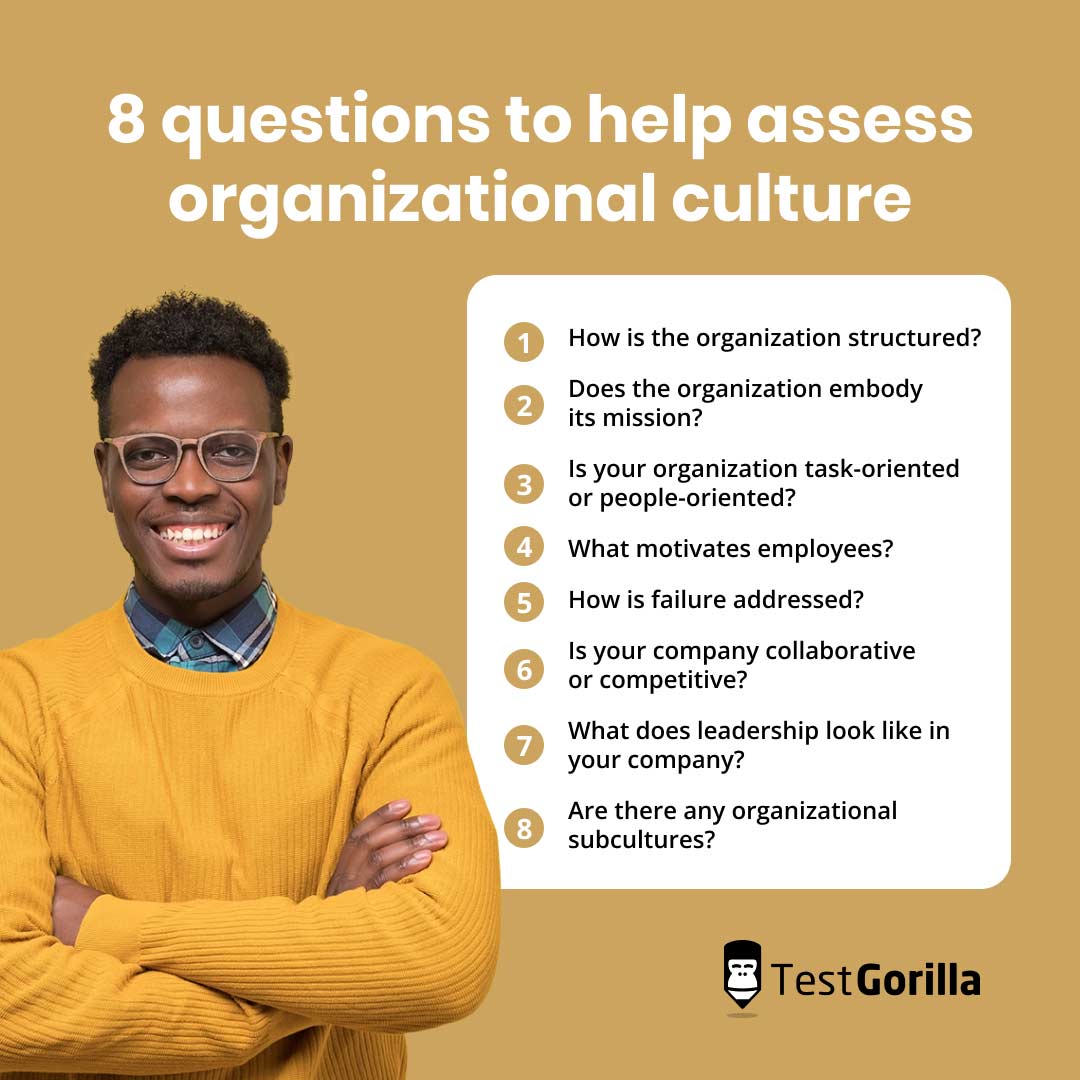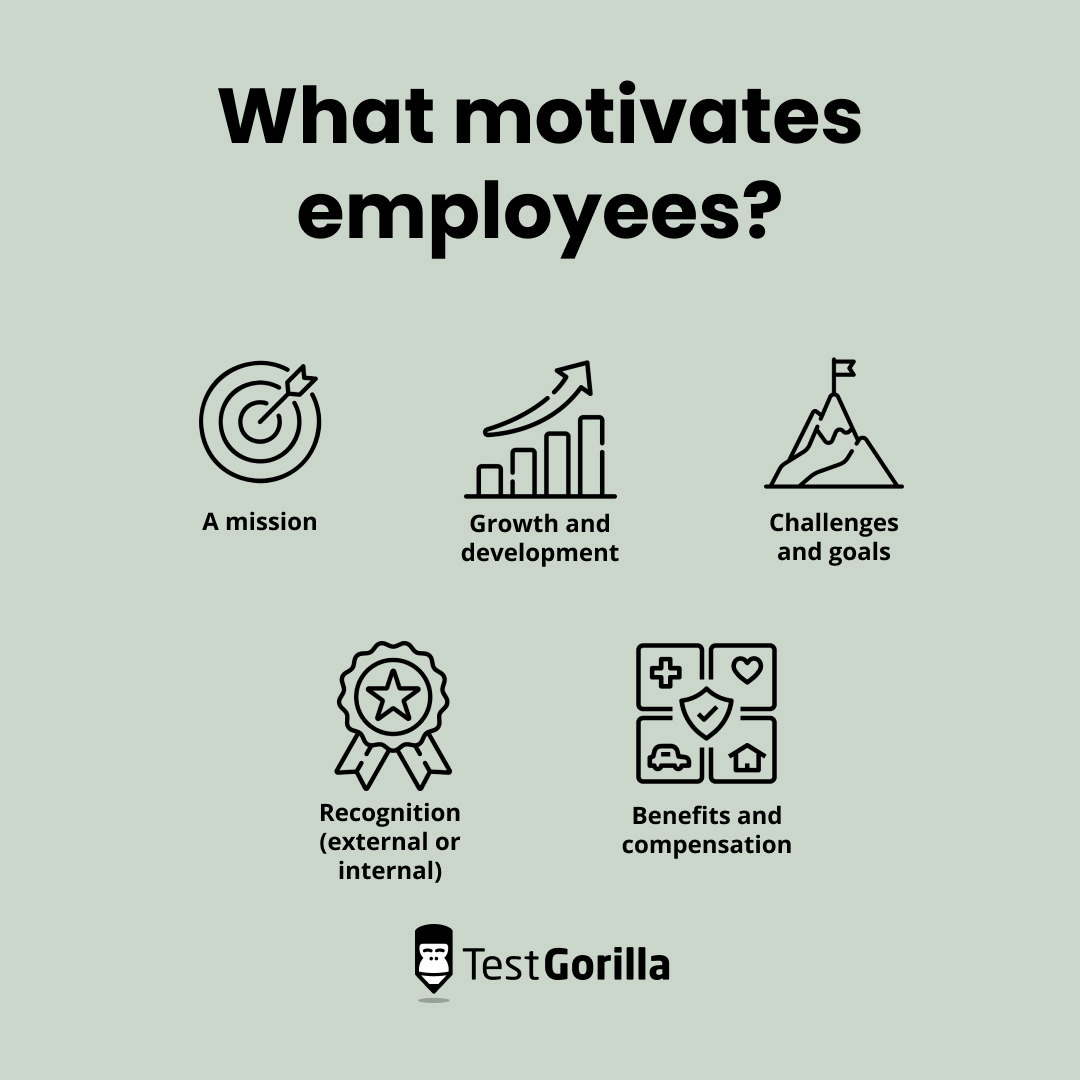Assessing organizational culture: What to ask plus best practices
Imagine a workplace where employees feel appreciated and inspired. A place where collaboration is second nature, giving and receiving feedback between co workers is an everyday scenario, and every individual's unique talents are celebrated.
This is what a thriving organizational culture is about.
Keep reading as we explore the ins and outs of organizational culture and why nurturing culture in your company is important. If you're part of a human resources team, you'll also learn sample questions to help you evaluate and assess organizational culture.
Let's get into it.
Table of contents
- What exactly is organizational culture?
- Examples of organizational culture
- Why is organizational culture important?
- 8 questions to help you assess organizational culture
- The Organizational Culture Assessment Instrument (OCAI): What is it?
- Develop a robust and thriving company culture by assessing it regularly
What exactly is organizational culture?
Organizational culture, also called company culture, is the set of values, behaviors, practices, and attitudes that the company's employees share.
It represents the shared mindset, attitudes, and assumptions of employees, management, and stakeholders, influencing how they interact, make decisions, and approach their work.
Organizational cultures can make or break even the strongest business models. An organization's current culture plays a vital role in shaping its overall performance, employee satisfaction, and how it is perceived internally and externally. It can be consciously cultivated by leadership or emerge organically over time based on the organization's history, employee behavior, and the personalities of its members.
Examples of organizational culture
Here are some examples of organizational culture:
Google: Google is renowned for its innovative and open culture. Employees are encouraged to think creatively and explore new ideas, even if they fail. The company's emphasis on a relaxed and fun work environment, with perks such as free meals and game rooms, fosters a sense of creativity and camaraderie among its workforce.
Zappos: Zappos is known for its customer-centric culture. The company strongly emphasizes delivering exceptional customer service and encourages employees to go above and beyond to exceed customer expectations. This customer-focused culture has been key to Zappos' success as an online retailer.
NASA: NASA's organizational culture is built around integrity, teamwork, safety, and excellence. The agency's focus on pushing the boundaries of human knowledge and exploration has been instrumental in achieving groundbreaking advancements in space science and technology.
These examples demonstrate how a healthy culture can profoundly influence a company's success. Each company's culture shapes its identity and has a significant impact on its ability to thrive and innovate in its respective industry.
The best insights on HR and recruitment, delivered to your inbox.
Biweekly updates. No spam. Unsubscribe any time.
Why is organizational culture important?
While organizational culture is a broad and elusive concept, its impact is actually quantifiable. A 2019 report by SHRM revealed that the cost of turnover because of a toxic workplace culture exceeded $223 billion for the past 5 years in the US alone. These are the direct losses that employers needed to bear because of failing to create a workplace environment where employees could feel heard and respected, and that was motivating for them.
Job satisfaction is tightly related to both what your company culture is and how you’re communicating it to your employees. Conflicting messages will erode your employees’ trust while acting with integrity will foster loyalty and openness.
Creating and nurturing a strong organizational culture will help your team in several ways. It'll help:
Improve performance and productivity
A positive culture that values collaboration and empowers employees can improve performance and increase productivity. Employees who feel motivated and appreciated are likelier to invest their best efforts in achieving the organization's long term goals.
Boost employee engagement
A thriving culture fosters a sense of belonging and purpose among employees, leading to higher levels of engagement. Engaged employees are more committed to their work, demonstrate increased productivity, and are less likely to seek employment elsewhere.
Attract talent, reduce turnover rates, and retain employees
A solid organizational culture is a magnet for top talent. It helps attract skilled individuals who align with the company values and mission. Furthermore, employees who find themselves in a culture that resonates with their values are more likely to stay with the organization long-term.
Foster innovation and creativity
A culture that encourages experimentation and risk-taking fosters innovation and creativity. Employees feel more comfortable sharing new ideas and approaches, leading to the development of groundbreaking solutions and products.
Promotes adaptability and resilience
A positive culture enables organizations to adapt quickly to changing circumstances and challenges. When employees feel supported and valued, they are more willing to embrace change and navigate uncertainties with resilience.
Better customer experiences
A culture that prioritizes customer satisfaction and service excellence results in better customer experiences. Employees who feel empowered to do their jobs and passionate about their work are likelier to go the extra mile to meet customer needs.
Enhances brand reputation
Organizational culture significantly impacts a company's brand reputation. A positive culture can create a strong and favorable impression on customers, partners, and the public, enhancing the organization's overall image.
Supports leadership development
A nurturing culture provides an environment that supports leadership development. It empowers employees to take on leadership roles, fostering a pipeline of skilled and capable leaders within the organization.
Learn more: How to hire great leaders
Employee well-being
A positive workplace culture prioritizes employee well-being and work-life balance. It recognizes the importance of supporting employees' physical and emotional health, leading to a healthier and more motivated workforce.
Learn more: How to improve employee wellbeing: 9 strategies for employers
Contributes to organizational longevity
Cultivating a positive culture contributes to organizational stability and longevity. A stable environment create a cohesive, resilient workforce that can weather challenges and sustain long-term success.
For these reasons, it makes sense to assess company culture regularly (for example every year), in order to be able to bridge the gap between your real and desired culture.
Assessing culture is the first step to figuring out if your real organizational culture is in line with your stated values. This will allow you to map out different ways to improve it.
8 questions to help you assess organizational culture
Let’s now look at the sample questions for a cultural assessment and the rationale behind each one.
1. How is your organization structured?
The first question to ask would be about your organizational structure. In it, you can include the following subtopics and clarifying questions:
How many levels of leadership are there?
Do you have a big (and diverse) leadership team, or are just a few people responsible for the key decisions at your organization?
Is the structure of your organization formal or informal?
Do you need to go through official channels, or is it ok for people to bypass authority sometimes?
Based on the answers to these questions, you’d be able to assess the hierarchical structure of your organization:
Highly hierarchical structure: If your company is highly hierarchical, you probably have a well-defined formal structure with a few different levels of leadership.
Moderately hierarchical structure: A moderate level of hierarchy means that people have well-defined roles with specific degrees of authority assigned to each role, but that it’s ok to question authority and work outside of the hierarchical framework sometimes.
Flat hierarchical structure: For companies with a low degree of hierarchy (also known as flat hierarchy), this means that employees can bypass and challenge authority, and that roles aren’t strictly defined.
2. Does your organization embody its mission?
If you asked 10 employees what the mission of your organization is, would you get 10 similar responses or 10 different ones?
The culture of an organization should align with its mission, which, in turn, should be clearly communicated to both your employees and clients. If your employees struggle to define your mission, or if you’re getting answers that vary a lot, it’s a good idea to look into the reasons for this.
You cannot artificially create a specific company culture you’d like to have: your culture is what you do, not what you say.
Maybe you have never explicitly defined the principles that inform your actions, but these principles still exist and are real. Your mission should be one of the cornerstones defining your organizational culture.
3. Is your organization people-oriented or task-oriented?
A people-oriented organization focuses on the motivation of its employees in order to maintain productivity and perform well. Meanwhile, a task-oriented organization focuses more on efficiency and puts tasks, processes and workflows first.
Task-oriented companies are often more formal and hierarchical in structure, while in people-oriented organizations, employees have a higher degree of independence and autonomy.
To further assess this, consider the following question: does your organization’s orientation make sense, considering your industry and mission?
A large multinational bank will probably operate differently than a small advertising agency, and that’s normal.
There isn’t a right or a wrong answer, but whatever the answer is, it needs to be in line with what you’re communicating, both externally and internally.
“People first” is one value many companies communicate to the outside world, but not all of them actually live by it, and a misalignment between the desired and the real organizational culture will create bitterness and distrust.
4. What motivates employees?
Motivation is highly personal and will inevitably vary from person to person, but if you’re able to pinpoint what motivates your employees, you’ll probably notice a pattern. So, what motivates your employees most? It could be a number of things, such as:
A sense of mission
Opportunities for growth and development
Challenges and goals
Recognition (external or internal)
Benefits and compensation
Alternatively, it might also be a fear of underperforming (and its consequences), in which case you probably need to inspect its sources and address them.
Motivation can be considered from another point of view as well: we could differentiate between intrinsic versus extrinsic motivation. Let’s look into that further:
If your employees are motivated intrinsically, this means they are working because they find satisfaction and fulfillment from within.
If they are motivated extrinsically, they are working for external rewards (recognition, benefits, etc.).
Intrinsic motivation is key to long-term employee satisfaction and productivity, and employees whose values align with those of their company are more likely to be intrinsically motivated to do the best work they can.
You can assess potential employees for culture compatibility with our culture add test, or also with a personality test.
5. How is failure addressed?
Every company and every employee will inevitably fail at some point. Of course, major failure is never ideal, and most organizations will strive to prevent it, as it can cost them clients, money, and even their reputation.
However, the way you address team failures is crucial to your culture:
Is failure viewed as an opportunity to strengthen bonds within the organization and as a lesson to learn from and grow?
Or do moments of failure divide the organization and lower morale?
When an organizational culture is one where employees fear failure, this leaves less room for innovation and experimentation. In this case, tried-and-true methods prevail, and there’s a high degree of predictability of the outcomes.
Some organizations, such as Netflix, Amazon, and Coca-Cola, actively seek to learn from failure: if you want to experiment and innovate, this implies that you’re taking risks, in which case the occasional failure is inevitable. However, the way you handle failure might sometimes heavily depend on your sector or industry as well.
6. Is your company collaborative or competitive?
Would your organization benefit more from collaboration between team members or competition between team members?
When assessing whether your company is competitive or collaborative, you need to keep in mind that neither is right nor wrong, but that one of them is simply a better fit for your organization.
Organizations with a strong competitive culture are often fast-paced and they benefit from employees who put in extra effort and achieve specific results, which are often closely tied to profits, market share, volume of sales, response times, etc. When a competitive culture goes wrong though, it can lead to ethical compromises like with Wells Fargo, which has paid a $3 billion settlement for using fraudulent sales practices (which resulted from, among other factors, their high-pressure work environment).
According to Harvard Business Review, one way to check if a competitive work environment is leading to a positive or toxic culture is to identify whether employees feel anxious or excited in their work environment, especially when you’re announcing the next goals and performance targets. You could use anonymized surveys to check that.
Meanwhile, collaborative organizational culture is essential for organizations where coordinated group effort and greater consensus are necessary to get the best results. One of its biggest pluses is the high rate of employee satisfaction and retention. A dysfunctional collaborative culture can lead to high performers feeling weighed down by a disorganized team, however.
7. What does leadership look like in your company?
Leadership represents your company culture more than almost anything else. Wise leaders understand that their leadership has a direct impact on how employees feel and perform, and whether they’re likely to stay.
In fact, according to SHRM’s 2019 report, 6 out of 10 people who have left a job, have taken this decision because of their managers and the toxic workplace environment they create.
For this part of your organizational culture assessment, you could ask the following questions:
Do managers lead by example?
Do they delegate tasks efficiently?
Are there any power struggles within the leadership team?
Is there a positive dynamic between leaders and their teams?
Besides this, you could assess the diversity of your leadership, and how it’s affecting both your performance and your company culture. According to a 2020 report by McKinsey, companies that have more diverse leadership are more successful and have a better chance of outperforming their competitors.
8. Are there any organizational subcultures?
If your organization has specialized teams and/or multiple locations, it’s likely that subcultures will develop within it. A subculture in this context refers to the fact that each team or location has a slightly different way of doing things.
It’s important to analyze whether the subcultures within your organization are compatible and consistent with your overall organizational culture:
A compatible subculture is beneficial to your organization and means that different teams and levels can communicate easily and work together smoothly.
If a subculture is incompatible with your organizational culture, this might create conflict between teams, or be detrimental to morale. If there are parts of an organization that don’t work together well, this may be a culture clash issue.
Of course, different locations or teams might function differently simply because of the nature of their work or because of cultural specifics. You need to address this proactively and define how you’d like to handle this.
The Organizational Culture Assessment Instrument (OCAI): What is it?
The Organizational Culture Assessment Instrument (OCAI) is a tool that helps determine and evaluate an organization's culture based on the Competing Values Framework. It is widely used by researchers, consultants, and leaders to understand an organization's current culture and its desired future culture.
The OCAI is based on the Competing Values Framework (CVF), which identifies four main types of organizational cultures:
Clan culture: Characterized by a friendly and collaborative environment, this culture emphasizes teamwork, employee development, and a family-like atmosphere. The focus is on mentorship and nurturing relationships.
Adhocracy culture: A dynamic, innovative culture that encourages risk-taking, creativity, and entrepreneurship. Organizations with this culture value experimentation and are quick to adapt to change.
Market culture: This culture is results-oriented and highly competitive. Organizations with a market culture prioritize achieving goals, meeting targets, and maintaining a competitive advantage.
Hierarchy culture: A culture that values stability, structure, and control. Organizations with a hierarchy culture have well-defined roles, clear procedures, and a focus on efficiency and stability.
The OCAI typically involves surveys or questionnaires administered to employees or key organizational stakeholders. Participants are asked to rank a series of statements representing the four culture types based on their perception of the organization's current culture and the culture they believe would be most beneficial for the organization's future. The process may also involve workshops and focus groups within the organization.
Develop a robust and thriving company culture by assessing it regularly
Change begins with assessing where you stand. Assessing your company's organizational culture is the first step to creating a stimulating work environment where employees feel heard, appreciated, respected, and safe. You also want them in a physical environment where they're productive and efficient.
Company culture directly impacts how well your company will perform in the future. It also needs to evolve constantly to support your objectives, which is now more urgent than ever. In their 2018 Global Culture Survey, Katzenbach Center and PWC found out that 80% of respondents said their organization's culture must change in the next five years for their organization to be successful and grow.
Try TestGorilla for free so you can start assessing your organizational culture.
Recommended reading:
You've scrolled this far
Why not try TestGorilla for free, and see what happens when you put skills first.




















